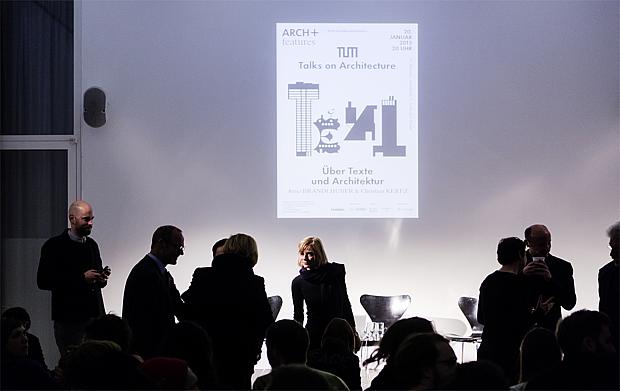|
| What value is attached to the text in the work of the architect? This issue was discussed by participants of the ARCH+ features event at the Vorhoelzer Forum of Munich's Technical University. |
Moderator Stephan Trüby talked to Arno Brandlhuber and Christian Kerez about their projects and the ambivalence of text production and building production. |
 |
|
|
Arno Brandlhuber is the founder of the brandlhuber+ architectural bureau and Professor of Architecture and Urban Research. His work is characterized by the subversive way it deals with the social, economic and political rules which influence architects.
One expression of this can be reduction to bare essentials in times of progressive growth – as seen in his Antivilla. Here, he reduces the useful area in winter by using suspended PVC film curtains to reduce energy consumption. But it can also be expressed in exaggerated gestures as for example in Brunnenstraße in Berlin, the location of his office. Painstakingly and with exaggerated precision, Brandlhuber fulfilled the environmental requirements imposed on the building. The roof is now extremely steep so as to afford the neighbouring building a fair share of sunshine.
|
|
|
Oft setzt Brandlhuber sich, begleitend zu seinen Projekten, schriftlich mit den auf ihn wirkenden Kräften auseinander. Für den Architekten ist die Textproduktion ebenbürtig zur Gebäudeproduktion.
Im politischen und gesellschaftlichen Diskurs ist der Text für ihn ein mächtiges Instrument. Er entwirft so ein Pendant zu den Baugesetzen und den unterschwelligen politischen und wirtschaftlichen Erwartungshaltungen, denen Architektur genügen soll.
|
|
|
The Swiss architect Christian Kerez also takes a debate-provoking intellectual approach. Kerez, who teaches design and architecture at the ETH Zurich, attaches great importance to the things that influence him in his work. Alongside the actual designs of his buildings, his website also features photos, film excerpts, written tracts about architecture and notices about exhibitions. Everything which "does not fit in anywhere else" but which has still influenced his work. |
|
|
Even the barriers which impede his creative design activity act as a catalyst for his work, for instance building regulations. For him, the design of a building is always a confrontation with the rules he is required to abide by. "I measure my performance against them, I bounce my work ideas off them", says Kerez. The outcome of one such wrestling match is a building on Lake Zurich, which was planned to comply precisely with the building regulations down to the most minute detail. And which promptly drew an objection from the building authorities. |
|
|
So there are two different forms of text which influence the work of the two architects. One is the architect's own creative text which intellectually anticipates and accompanies the design of a building. The other is the prescriptive rule set stipulated by building laws or building owners which architects are required to deal with. A balance has to be continuously struck with these two opposite ends of the spectrum. |
|
|
The narrative scope afforded by the architecture is illustrated in the custom-produced door station which Siedle produced for Arno Brandlhuber's Antivilla. Its material, untreated aluminium cast into shape in the Black Forest, tells a number of different stories.
It harks back to the traditional roots of the company Siedle, which evolved from a foundry for the Black Forest clockmakers. At the same time, the surface of the door station is reminiscent of the building's chequered history: It was moulded as a cast of the GDR render used to envelop the building. The oxidation of the untreated material is a deliberate effect, the weathered look of the structural elements gives expression to the concept of Brandlhuber's architecture, which lends history and temporality their own inherent value.
|
|
|
Packed to full capacity, the Vorhoelzer Forum was too small to accommodate the crowd. Over 250 people were able to follow the event by live relay broadcast into the ante-room. |
|
|
Centre: Arno Brandlhuber, in the foreground Anh-Linh Ngo, Editor of ARCH+. |
|
|
In conversation: Andres Lepik, Director of the Architecture Museum at the Technical Museum of Munich, and Peter Cachola Schmal, Director of the German Architecture Museum in Frankfurt.
All photos: David von Becker. |
|
|